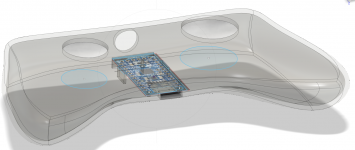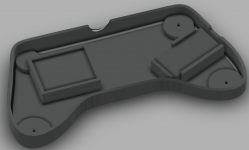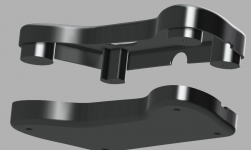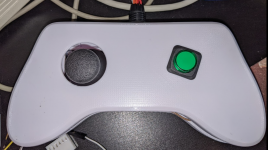// The quadrature phases to output
const bool waveform1[] = {HIGH, LOW, LOW, HIGH};
const bool waveform2[] = {HIGH, HIGH, LOW, LOW};
const int doNothingTolerance = 40; //no movement if you don't reach this miminal threshold
const int pureDirectionTolerance = 200; //if a direction has that, but the other doesn't, lock it in the direction that has it
int xGPIOs[] = {6, 5};
int yGPIOs[] = {4, 3};
const int xAnalogue = 3;
const int yAnalogue = 2;
const int clickOutGPIO = 10;
const int clickInGPIO = 11;
// Two digital outputs set permanently to high and low, respectively, to reference
// the variable resistors with
const int hiRefGPIO = 13;
const int loRefGPIO = 12;
// the timestamps (in milliseconds) when the axis last was updated
unsigned long xTimestamp = 0;
unsigned long yTimestamp = 0;
// the indexes into the waveforms
int xIdx = 0;
int yIdx = 0;
int xIsStill() {
return analogueValueIsStill(analogRead(xAnalogue));
}
int yIsStill() {
return analogueValueIsStill(analogRead(yAnalogue));
}
long xDelay() {
return analogueValueToDelay(analogRead(xAnalogue));
}
long yDelay() {
return analogueValueToDelay(analogRead(yAnalogue));
}
int xDirection() {
return analogueValueToDirection(analogRead(xAnalogue));
}
int yDirection() {
return analogueValueToDirection(analogRead(yAnalogue));
}
int xShouldAdvance() {
unsigned long now = millis();
// if the joystick is in the "still" region, don't update
if (xIsStill()) {
return 0;
}
if ((xTimestamp + xDelay()) < now) {
xTimestamp = now;
return 1;
} else {
return 0;
}
}
int yShouldAdvance() {
unsigned long now = millis();
// if the joystick is in the "still" region, don't update
if (yIsStill()) {
return 0;
}
if ((yTimestamp + yDelay()) < now) {
yTimestamp = now;
return 1;
} else {
return 0;
}
}
int xIsWellEstablished() {
unsigned long now = millis();
// if the joystick is in the "dominating" region
if (analogueValueIsDominating(analogRead(xAnalogue))) {
return 1;
}
}
int yIsWellEstablished() {
unsigned long now = millis();
// if the joystick is in the "dominating" region
if (analogueValueIsDominating(analogRead(yAnalogue))) {
return 1;
}
}
void dealWithButton() {
int btn = digitalRead(clickInGPIO);
digitalWrite(clickOutGPIO, btn);
}
int analogueValueIsStill(int value) {
if (value > (512 + doNothingTolerance)) {
return 0;
}
if (value < (512 - doNothingTolerance)) {
return 0;
}
return 1;
}
int analogueValueIsDominating(int value) {
if (value > (512 + pureDirectionTolerance)) {
return 1;
}
if (value < (512 - pureDirectionTolerance)) {
return 1;
}
return 0;
}
int analogueValueToMagnitude(int value) {
return abs(value - 512);
}
int analogueValueToDirection(int value) {
if (value < 512) {
return -1;
}
return 1;
}
long analogueValueToDelay(int value) {
const long minDelay = 4;
long mag = analogueValueToMagnitude(value);
return ((512 - mag) / 32) + minDelay;
}
void writeQuadrature(int gpios[], int idx) {
digitalWrite(gpios[0], waveform1[idx % 4]);
digitalWrite(gpios[1], waveform2[idx % 4]);
}
void setup() {
Serial.begin(9600);
// set up quadrature outputs
pinMode(xGPIOs[0], OUTPUT);
pinMode(xGPIOs[1], OUTPUT);
pinMode(yGPIOs[0], OUTPUT);
pinMode(yGPIOs[1], OUTPUT);
pinMode(clickInGPIO, INPUT_PULLUP);
pinMode(clickOutGPIO, OUTPUT);
pinMode(hiRefGPIO, OUTPUT);
digitalWrite(hiRefGPIO, HIGH);
pinMode(loRefGPIO, OUTPUT);
digitalWrite(loRefGPIO, LOW);
digitalWrite(xGPIOs[0], HIGH);
digitalWrite(xGPIOs[1], HIGH);
digitalWrite(yGPIOs[0], HIGH);
digitalWrite(yGPIOs[1], HIGH);
digitalWrite(clickOutGPIO, HIGH);
Serial.print("initialised...\n");
}
void loop() {
dealWithButton();
//clear cut x movement only
if (xShouldAdvance() && xIsWellEstablished() && !yIsWellEstablished()) {
xIdx = (xIdx + xDirection()) % 4;
if (xIdx < 0) { xIdx += 4; }
writeQuadrature(xGPIOs, xIdx);
return;
}
//clear cut y movement only
else if (yShouldAdvance() && yIsWellEstablished() && !xIsWellEstablished()) {
yIdx = (yIdx + yDirection()) % 4;
if (yIdx < 0) { yIdx += 4; }
writeQuadrature(yGPIOs, yIdx);
return;
}
//weak x
if(xShouldAdvance()) {
xIdx = (xIdx + xDirection()) % 4;
if (xIdx < 0) { xIdx += 4; }
writeQuadrature(xGPIOs, xIdx);
}
//weak y
if(yShouldAdvance()) {
yIdx = (yIdx + yDirection()) % 4;
if (yIdx < 0) { yIdx += 4; }
writeQuadrature(yGPIOs, yIdx);
}
// DEBUG:
//Serial.print("x: ");
//Serial.print(analogRead(xAnalogue));
//Serial.print("y: ");
//Serial.print(analogRead(yAnalogue));
//Serial.print("button: ");
//Serial.print(digitalRead(clickInGPIO));
//Serial.print("\n");
}






